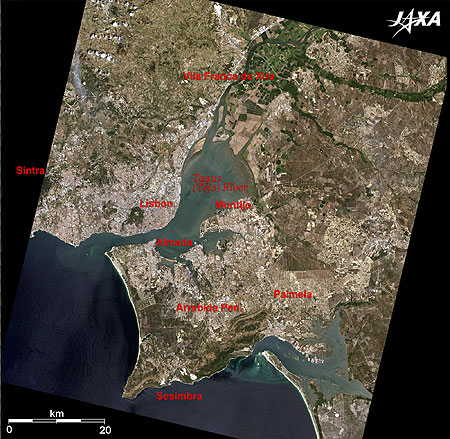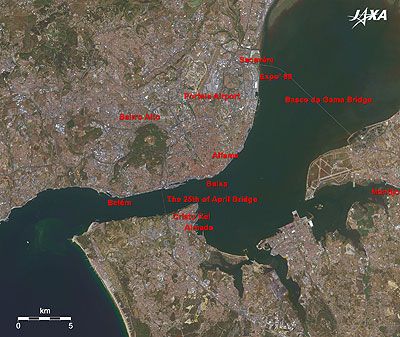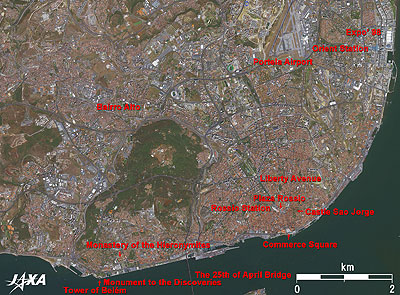Seen from Space 2008
Lisbon, Portugal - Where the Land Ends and the Sea Begins
Lisbon prospered more than Venice during the Age of Discovery from the 15th century with spice trade. However, the city suffered the Great Earthquake in 1755 and was almost destroyed. The city was subsequently rebuilt and organized in a beautiful grid system. Monument of Cristo Rei, which resembles the Corcovado monument in Rio de Janeiro, stands in Almada on the opposite bank of the river. The summer residence of 14th-century Portuguese kings was located in Sintra, 20km west of Lisbon. Sintra is a base station for visiting Cape Roca, the westernmost point of the Eurasian Continent (Cape Roca is not visible in the figure). Sintra is the location of the monument of "where the land ends and the sea begins" by Portuguese poet Luú de Camões (1524-1580). The National Palace of Pena and the castle were added to the list of World Cultural Heritage sites of the United Nations Educational, Scientific and Cultural Organization (UNESCO) in 1995 as "Cultural Landscape of Sintra." Vila Franca de Xira, located 30km north of Lisbon and situated on the west bank of the River Tagus, is well-known for its bullfighting and bull-running festivals "Festa do Colete Encarnado." You can see large farms on the east bank of the river, and numerous circular fields with large sprinklers are clearly visible. Sesimbra is located on the south coast of the Arrabida Peninsula and is well known for its fishing villages, fish restaurants, and resort areas for citizens of Lisbon. Palmela with Moors castle is located east of Sesimbra. Muslims and Christians in the castle battled repeatedly in the middle of the 12th century.
The longer bridge on the right is the Vasco da Gama Bridge between Sacavém and Montijo. Its 17.2km length makes it the longest bridge in Europe. Expo E8 was held in Sacavém at the foot of the bridge. The bridge was opened in 1998 and was named to commemorate the 500th anniversary of the discovery of the sea route from Europe to India by Vasco da Gama (1469-1524). The Belém area, located west of Lisbon, is one of the most favorite places due to its many monuments of the Age of Discovery. The Bairro Alto area, a high-rise area north of Belém, is one of the oldest districts in Lisbon and is home to many Fado singing clubs and small restaurants. Alfama east of Bairro Alto is also one of the oldest districts in Lisbon and has many Fado bars and restaurants with many alleys. One of these is the Baixia area, a lowland area that was rebuilt after the Great 1755 Earthquake. It is also called Lisboa Pombalina, and its streets are laid out in grids. Lisbon Portela International airport is located north of Lisbon.
Manuel I began the construction of the white Monastery of the Hieronymites in 1502, and it was completed 300 years later. It was funded using the enormous riches of Vasco da Gama’s spice trade. The Monastery of the Hieronymites and the Tower of Belém were added to the list of World Cultural Heritage sites of the United Nations Educational, Scientific and Cultural Organization (UNESCO) in 1983. Commerce Square (Plaza del Cormecio) in the Baixa area is the ruins of King Manuel I’s royal residence destroyed in the Great 1755 Earthquake. Plaza Rossio is most crowded, and horseshoe-shaped Rossio station is visible in the same area. The avenue in the north from the Rossio station is Liberty Avenue (Avenida da Liberdade) and is an important avenue in central Lisbon modeled after Avenue of Champs-Élysées in Paris. Expo E8 was held in 1998 with the theme "The Oceans, a Heritage for the Future." Most main pavilions still remain, and the Park of the Nations was opened to the public after Expo E8. It has one of the larger aquariums in Europe and a major shopping center, making it a place of recreation and relaxation for the citizens.
|







